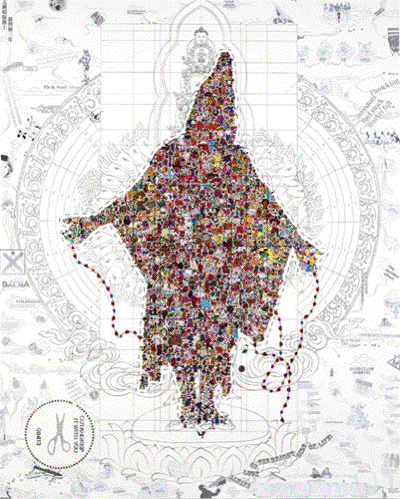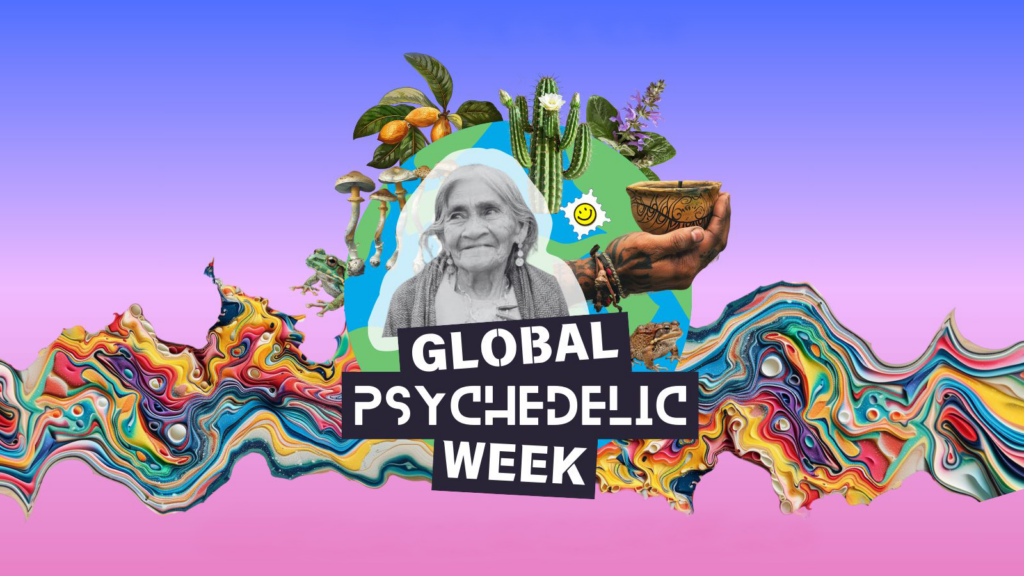Angel, 2007
With China’s accelerating economy growing by 11 percent a year, economic goals are paramount and spiritual values are either ignored or suppressed. Yet in the art world, spiritual longing can be tapped without fear of overt reprisal. Drawing from their long history of Buddhism, Tibetan artists are leading the way in exploring this issue.
Lhasa has changed. It is a city bursting with pilgrims from all over the world prostrating in front of the Jokhang, as well as host to a plethora of nightclubs with kitschy shows of Tibetan culture, spewing hoards of drunken patrons into the streets at dawn. Life for the artists of Tibet has undergone a similar transformation. Growing up during the turbulent 1960s – a time of food rationing, memories of Chairman Mao, and rapid modernization under Deng Xiao Ping – a generation of Tibetan artists witnessed the changes occurring in China from within their own cultural perspective.
These artists eventually grew tired of being exoticized in the West as “mystics,” and felt constrained by China’s Soviet-based “realistic” style of painting (which led to a generation of Han Chinese depicting them as the equivalent of noble savages). In 2003, thirteen Tibetans and two Chinese living inside Tibet formed the Gendun Choephel Artists Guild, an organization of artists that hosted monthly rotating exhibits. They dismissed the general perception among Chinese of Tibetans as simply “ethnic,” and they fiercely defended their right to express their own identity.
It is a relatively recent situation for Tibetans to remove art from its iconographical, religious origins of thangkas and scrolls and recontextualize it within the modern dialectic. The most striking example of this process can be found in the work of Gonkar Gyatso, an artist who uses ideological identity portraiture and sophisticated graphics to discuss the modernist dilemma facing contemporary Tibetans. Gyatso has resided within Tibet, China, India and London, and he reflects on his diverse identity within these different locales. In Angel, he incorporates the tig-say, or traditional iconographic grid, drawing the outlines of the 100,000-armed god of compassion, Avaloketishvara, while also framing the deity in a modern patchwork composition with a pointillistic, collage-like effect.
In My Identity 1-4, Gyatso represents himself alternately as a Tibetan native painting a traditional thangka; a Communist Chinese painting a portrait of Mao; a refugee painting a picture of The Dalai Lama; and finally, an international urban sophisticate painting a picture of the cosmos. Who, however, is the real Gonkar?
What is his actual tradition? Where does the truth lie?
My Identity No. 1
My Identity No. 2
My Identity No. 3
My Identity No. 4
Gande is another artist with a deep appreciation of traditional forms. He imbues them with a secondary, critical meaning. For example:
Light Ray
In Light Ray he has taken the traditional mandala circle and filled it with the 100,000 hands of Avaloketishvara. Pushing the form of the grid further, he abstracts it into a series of boxes, breaking out of the time honored form of a thangka to take apart its basic elements. This theme of taking important religious symbols and substituting capitalist ideology is highlighted in his hilarious New Scripture Series piece, Mickey Thangka, which features the tig-say faces of the Buddha and Mickey Mouse. In another piece from the series, Gande depicts Ronald McDonald in the place of the Buddha, on a folio leaf containing texts that contain writing from a Chinese personals ad.
New Scripture Series, Mickey Thangka
New Scripture Series, Ronald McDonald
In the images below, Pewang takes as his subject matter the five mental afflictions of traditional Buddhist thought: desire, aggression, greed, jealousy, and pride. He paints them as celestial deities incorporating traditional flowers, clouds, hand gestures, shading of the body and flora backgrounds.
Envy
Ignorance
The artist Kesang works with the notion of the bardo, the realm one enters after death and before rebirth. Here, the bardo is represented as a light infused circle that leads to a skull and cross bones.
Skull
Though not radical by Western standards, this type of imagery is a huge leap for traditionally trained Tibetan painters. Using this kind of representation signifies an enormous perceptual shift, uncoupling religious or spiritual painting from its strict iconographic past.
However, not all Tibetan painters are fixated on religious, iconographical or spiritual issues. Tsewang Tashi employs a neo-realist style taught in Chinese art academies to present the faces of young Tibetans boldly staring at the viewer. Though fresh-faced, they also appear cautious, with pursed, closed lips. It is impossible to know what they are thinking, but their expressions are provocative. These portraits are the faces of Tibet’s future.
Untitled 3
Untitled 1
Finally, there is the provocative work of Nortse. Using both painting and photography, he depicts images of individuals who are rendered mute by their covered faces. In the first painting below, Nortse depicts three nearly identical individuals wearing dirty t-shirts. Their bandaged faces stare starkly at the viewer.
Group Painting
In Group Photo, he again shows three bandaged and muzzled individuals, but with a twist. A woman holds a Tibetan prayer wheel while two men, one dressed in a suit and the other one bound with silver tape, display high-tech accoutrements – a cell phone and a space mask. These individuals are now in possession of more upscale silencers.
Group Photo
Contemporary Tibetan artists defy expectations. Many Western Buddhist practitioners would like to see them still produce strictly phonographic, spiritual art. The ecumenical modern art world looks at them as a fourth world minority playing catch up with the post modern predicament and a subset of the white hot Chinese art world. Tibetans themselves are split on the issue. They understand artists must address the rapid social, psychological and economic changes they are confronting as a people but are equally concerned they will lose their traditions in the overwhelming cultural tsunami of rapid globalization. What is certain is that the Gendun Choephal School is sure to address the current and future changes roiling Tibet.














